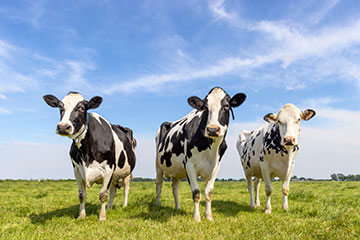Value without compromise
Jun 05, 2024

By Todd Steen, ProTrition Ruminant Nutritionist
Ensiled forages protect nutrient loss from harvest through storage, are relatively easy to feed, and can increase proficiency of ration mixing and handling versus dry forage. Feeding environment and convenience influence dairy cattle response to rations and forage concentration. These lactational and feed intake responses to a given forage will be influenced not only by fiber concentration and digestibility but also physical form. Many producers have already harvested ryegrass silage of excellent quality and, based on fertilization protocol and timeliness of harvest, a lot of this type of silage will have a nutrient profile similar to alfalfa. Since corn silage is usually the predominant forage, producers have the opportunity to add variety and manage feed supply risk without compromising potential milk production in selecting small grain for forage.
Generally, small grain forages provide between 70% to 90% of the feeding value of corn varieties. However, focusing on digestive quality with lesser emphasis on quantity provides additional high-energy forage. Preparing for harvest based on optimal moisture content should allow forage material to contain higher digesting fiber instead of dryer, rougher fibrous forages. Cutting small grain forage between “milk” and “dough stage” could increase crude protein (CP) concentration two (2) to three (3) percentage units versus cutting in “late-dough stage” or later without major reduction in overall tonnage per acre.
Ryegrass silage, as an example, will provide high concentrations of rumen-degradable nitrogen or CP and highly digestible fiber. The combination of ryegrass and corn silage provides the cow with proper concentration of energy and CP. Additionally, cutting when overall dry matter (DM) of the forage is <35% mostly provides a fiber package with peak digestibility promoting greater rumination and nutrient availability. Further, harvesting at ideal DM will allow for best possible fermentation of the forage and possibly increasing intake and acceptability of the forage. As an example, ryegrass silage acceptability declines rapidly as maturity of the crop increases. Typically, in the later portion of springtime, ambient temperatures can rise which in turn will speed up plant maturity.
These harvesting considerations can be applied to virtually any forage type to complement primary forage such as corn silage or another legume-type material. The intent of this approach is to provide high milk-producing rations at the best possible cost. For the most part, it is remarkably easy to incorporate alternative forages into rations without compromising production, while lowering ration cost.
Our team of livestock specialists are happy to work with producers and assist with forage needs and ration balancing. Visit your local Co-op to learn more.
Ensiled forages protect nutrient loss from harvest through storage, are relatively easy to feed, and can increase proficiency of ration mixing and handling versus dry forage. Feeding environment and convenience influence dairy cattle response to rations and forage concentration. These lactational and feed intake responses to a given forage will be influenced not only by fiber concentration and digestibility but also physical form. Many producers have already harvested ryegrass silage of excellent quality and, based on fertilization protocol and timeliness of harvest, a lot of this type of silage will have a nutrient profile similar to alfalfa. Since corn silage is usually the predominant forage, producers have the opportunity to add variety and manage feed supply risk without compromising potential milk production in selecting small grain for forage.
Generally, small grain forages provide between 70% to 90% of the feeding value of corn varieties. However, focusing on digestive quality with lesser emphasis on quantity provides additional high-energy forage. Preparing for harvest based on optimal moisture content should allow forage material to contain higher digesting fiber instead of dryer, rougher fibrous forages. Cutting small grain forage between “milk” and “dough stage” could increase crude protein (CP) concentration two (2) to three (3) percentage units versus cutting in “late-dough stage” or later without major reduction in overall tonnage per acre.
Ryegrass silage, as an example, will provide high concentrations of rumen-degradable nitrogen or CP and highly digestible fiber. The combination of ryegrass and corn silage provides the cow with proper concentration of energy and CP. Additionally, cutting when overall dry matter (DM) of the forage is <35% mostly provides a fiber package with peak digestibility promoting greater rumination and nutrient availability. Further, harvesting at ideal DM will allow for best possible fermentation of the forage and possibly increasing intake and acceptability of the forage. As an example, ryegrass silage acceptability declines rapidly as maturity of the crop increases. Typically, in the later portion of springtime, ambient temperatures can rise which in turn will speed up plant maturity.
These harvesting considerations can be applied to virtually any forage type to complement primary forage such as corn silage or another legume-type material. The intent of this approach is to provide high milk-producing rations at the best possible cost. For the most part, it is remarkably easy to incorporate alternative forages into rations without compromising production, while lowering ration cost.
Our team of livestock specialists are happy to work with producers and assist with forage needs and ration balancing. Visit your local Co-op to learn more.